135 Years Strong: Growing the Land-Grant Legacy Through Education and Outreach
Office of Communications and Marketing
Young Hall
820 Chestnut Street
Jefferson City, MO 65101
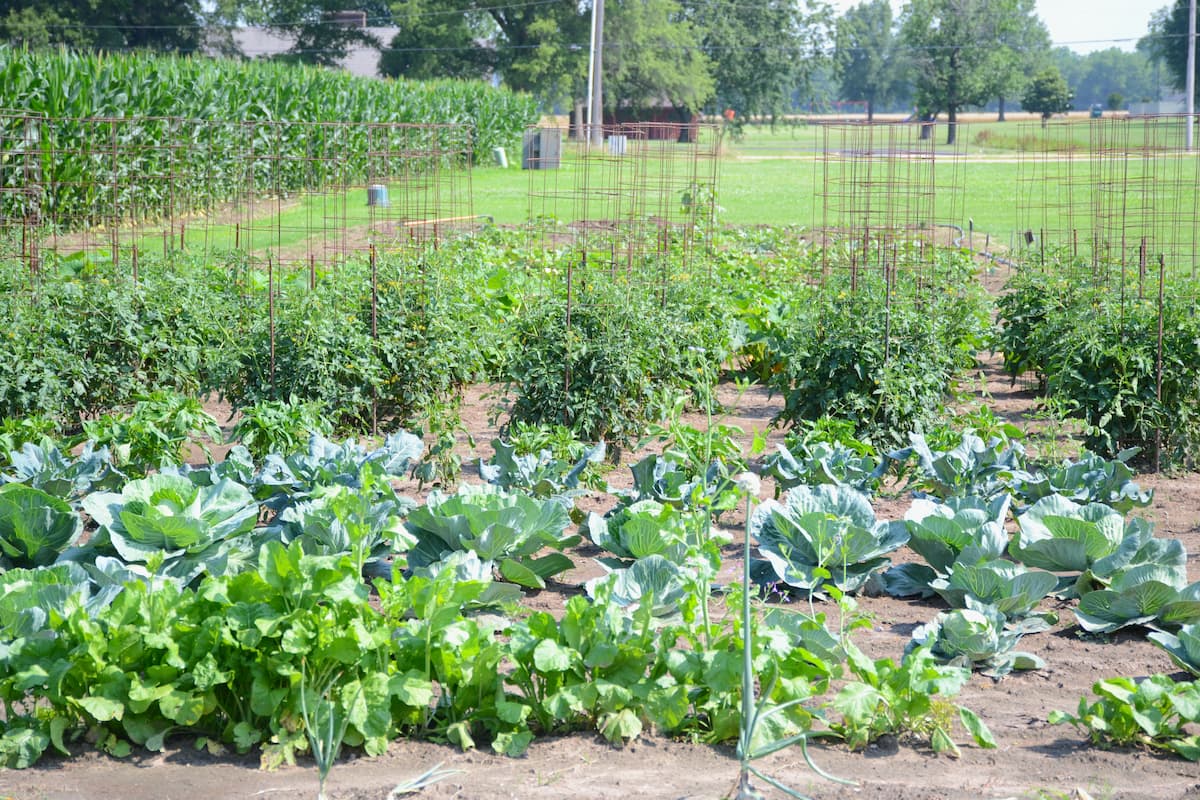 Rows of vegetables grow in the Charleston Garden, a Lincoln University-owned site supporting food access and outreach in Southeast Missouri.
Rows of vegetables grow in the Charleston Garden, a Lincoln University-owned site supporting food access and outreach in Southeast Missouri.
What began in 1890 with the Second Morrill Act — a milestone in expanding access to higher education for African Americans — continues to grow across the state through Lincoln University of Missouri (LU) and its Cooperative Extension programs. Rooted in agricultural education, Lincoln University Cooperative Extension (LUCE) helps communities grow food, pass down knowledge through generations and build healthier futures through a network of community gardens.
These spaces are more than planting grounds — they embody equity, opportunity and education, reflecting Lincoln University’s mission to uplift the communities it was created to serve.
The LUCE Charleston Outreach Center serves as a foundation for this work, leading efforts to reduce food insecurity in communities across Southeast Missouri, the Delta region, the St. Louis and Kansas City metropolitan areas, Springfield and areas near the Arkansas state line. One key effort is G.A.R.D.E.N. — Growing Area Gardens in Rural/Urban Destinations Encouraging Healthy Nutrition — a statewide initiative targeting food deserts and underserved neighborhoods. Backed by funding from the Missouri Department of Social Services, the program supports community gardens by providing essential resources, education and guidance.
“This work powerfully reflects the lasting impact of the Second Morrill Act,” says LUCE Charleston Outreach Center’s Sheryl Maxwell, who plays a key role in garden programming. “When I see a young person proudly harvesting vegetables they helped grow or an elder sharing their gardening knowledge with others, I see the spirit of that Act come to life.”
Maxwell added, “Community gardens offer more than food — they provide education, empowerment and a sense of purpose. They represent the kind of hands-on learning the Act intended to support, and they continue to fulfill its promise by helping communities grow stronger.”
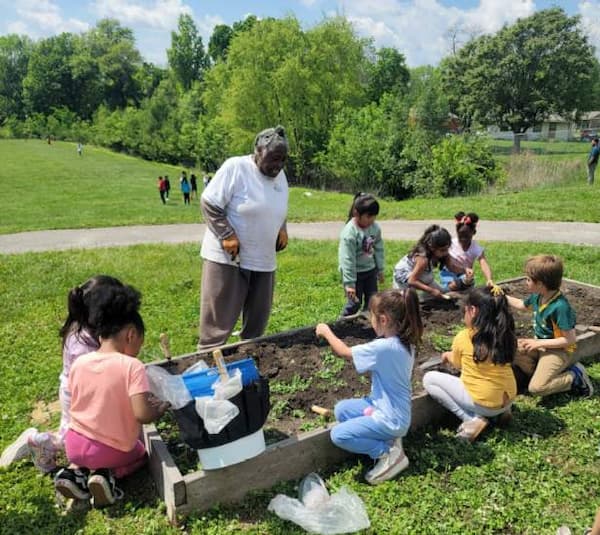 Children gather around a raised garden bed, planting seeds with guidance from Urban Green Dreams.
Children gather around a raised garden bed, planting seeds with guidance from Urban Green Dreams.
Whether hosted at community centers, schools, family plots or connected through churches and nonprofits, each garden supports unique local goals — donating food, engaging youth in agriculture or offering a place for neighbors to connect and learn together.
Owned and operated by Lincoln University, the Charleston Garden exemplifies the institution’s commitment to addressing food insecurity in Southeast Missouri. Working in close collaboration with the LUCE Charleston Outreach Center, the garden supports regional outreach efforts by providing fresh produce and fostering education.
Many LUCE-supported gardens are also paired with the Coming Together to Bridge the Gap Summer Institute, led by LUCE’s Charleston Outreach Center and 4-H Youth Development. This summer program provides academic enrichment, social-emotional learning and science-based experiences designed to reduce summer learning loss and cultivate the next generation of leaders. LUCE supports this work by supplying curriculum and financial support for teaching staff at participating sites.
One such location is the Taylor Center in Howardville, Missouri — a cornerstone of LUCE outreach and a participating Coming Together to Bridge the Gap site. But education doesn’t end with the season — the Taylors have been passing down gardening knowledge for generations, nurturing both plants and people with a legacy rooted in tradition and generosity.
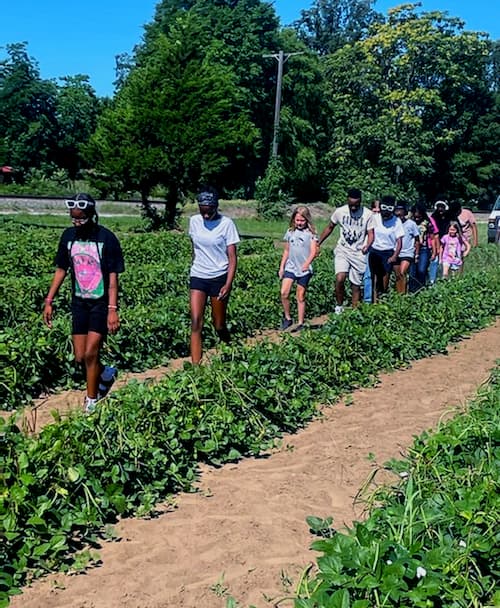 Youth walk between crop rows at one of several community garden sites affiliated with the Taylor Center.
Youth walk between crop rows at one of several community garden sites affiliated with the Taylor Center.
Operated by the Taylor family alongside local residents, the garden spans several plots throughout Howardville and nearby Lilbourn. Mary Lynn Taylor and her husband, Robert, both grew up with parents and grandparents who gardened and passed along their knowledge — something they now do for their own children and grandchildren.
“Our children and grandchildren help in the gardens,” Mary Lynn Taylor says. “My grandson can tell you all about plants — from the ground to the seed to the harvest. We’ve passed this knowledge through our family.”
She adds, “My husband, Robert Taylor, gets up early every morning, and he’s out in the garden. It’s just been a part of us, and that’s just what we know to do — to grow and help others to get what they need. We donate the food to the community — there’s no charge.”
The Garden of Peace in Sikeston stands as another example of how LUCE-supported spaces nourish both land and spirit. Started by the Prince of Peace Church, this garden operation was one of the first community gardens launched with the help of LUCE. While the garden is affiliated with the church, it serves the wider community and is maintained by a team of dedicated volunteers.
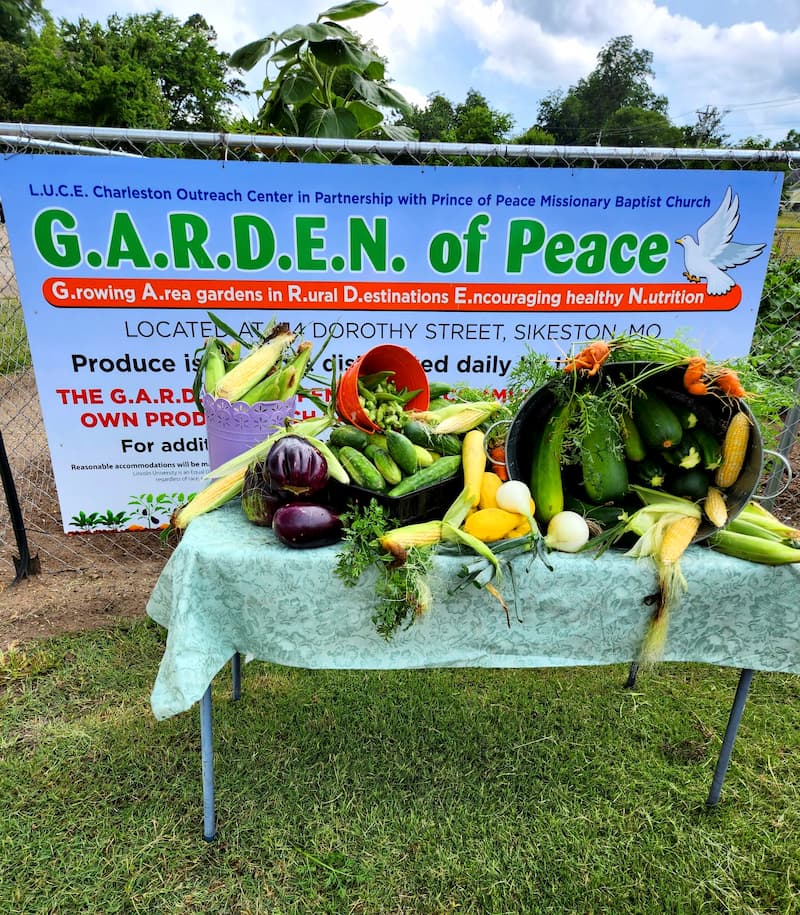 Fresh produce harvested from the Garden of Peace in Sikeston, Missouri, one of the many LUCE-supported community garden sites.
Fresh produce harvested from the Garden of Peace in Sikeston, Missouri, one of the many LUCE-supported community garden sites.
“This kind of work matters because some don’t have the health to garden, and with the cost of fresh food, some just can’t afford it,” Pastor Rick Anderson says. “One vine might give you seven, ten, even twenty cucumbers, but in the store, two cucumbers wrapped in plastic can cost two bucks. This garden helps fill that gap.”
Community members are welcome to stop by any day to pick up fresh vegetables harvested by the garden team. On Saturdays, they are also invited into the garden to pick produce themselves. This open access, paired with daily harvests, ensures that fresh food is consistently available and shared freely in Sikeston.
While the LUCE Charleston Garden, Taylor Center and the Garden of Peace thrive in rural Southeast Missouri, other sites flourish in urban areas like St. Louis. There, Growing Food, Growing People — led by Leah Lee Pulliam, executive director — supports a range of garden projects that bring fresh food and agricultural education to the Saint Louis region.
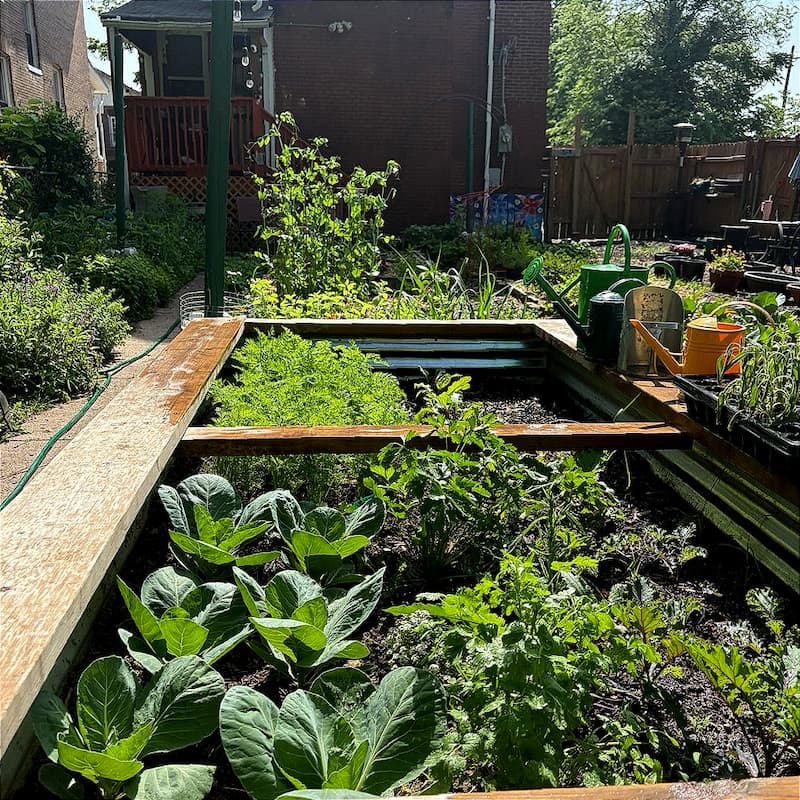 A vibrant garden bed at one of the Growing Food, Growing People sites in St. Louis — a strong example of urban gardening in action.
A vibrant garden bed at one of the Growing Food, Growing People sites in St. Louis — a strong example of urban gardening in action.
Her connection with Lincoln University began when Maxwell visited one of her gardens — an encounter that sparked ongoing collaboration. Since then, LUCE has provided Pulliam with tools, educational workshops and inspiration to expand her work and deepen her community impact.
“Lincoln and Ms. Sherry Maxwell have given me so many broader ideas on how to connect and impact my community,” Pulliam says. “They’ve helped make this work more sustainable.”
Pulliam tends multiple garden areas across the city, including sites at transitional homes, daycare centers, churches and neighborhood lots. Each space is tailored to meet the needs of its surrounding community, with a focus on accessibility and small-scale growing.
“Some people think that in order to grow food for your family, you need this massive space, and you really don't,” Pulliam says. “I love showing people what they can do with what they have — even if that’s just a five-gallon bucket.”
In addition to her gardening efforts, Pulliam operates a summer camp that operates as one of LUCE’s Coming Together to Bridge the Gap sites. With her mother, a retired educator, serving as the site coordinator, LUCE supports the program by providing curriculum resources and funding for summer teachers. Together, they blend hands-on garden activities with structured lessons to engage and empower youth.
LUCE’s reach also extends to Kansas City, where Urban Green Dreams, operates several gardens across the city — from schoolyards to community spaces and church lots — serving as a central hub for food access, youth engagement and community growth.
“We just got established as a 501(c)(3) this year, so that was a major success,” says Brooke Grimes, master gardener and horticulturist with Urban Green Dreams, reflecting on the new nonprofit status. “Every garden looks a little different, and each community center has a different need, so we have a little bit of everything amongst all of our gardens.”
At schoolyard sites, children help plant, harvest and learn by working directly in the garden. Much of the produce is eaten by students and teachers, while any excess is donated to community organizations that provide meals or food access.
“We are so grateful for Lincoln University," Grimes says. "We just recently got some stipends from Lincoln to help with our garden endeavors this year. We were needing supplies to do our schoolyard gardening, and Lincoln helped with that. I’m actually starting a summer camp next week with one of the community centers, and we're using some of the tools that Lincoln provided.”
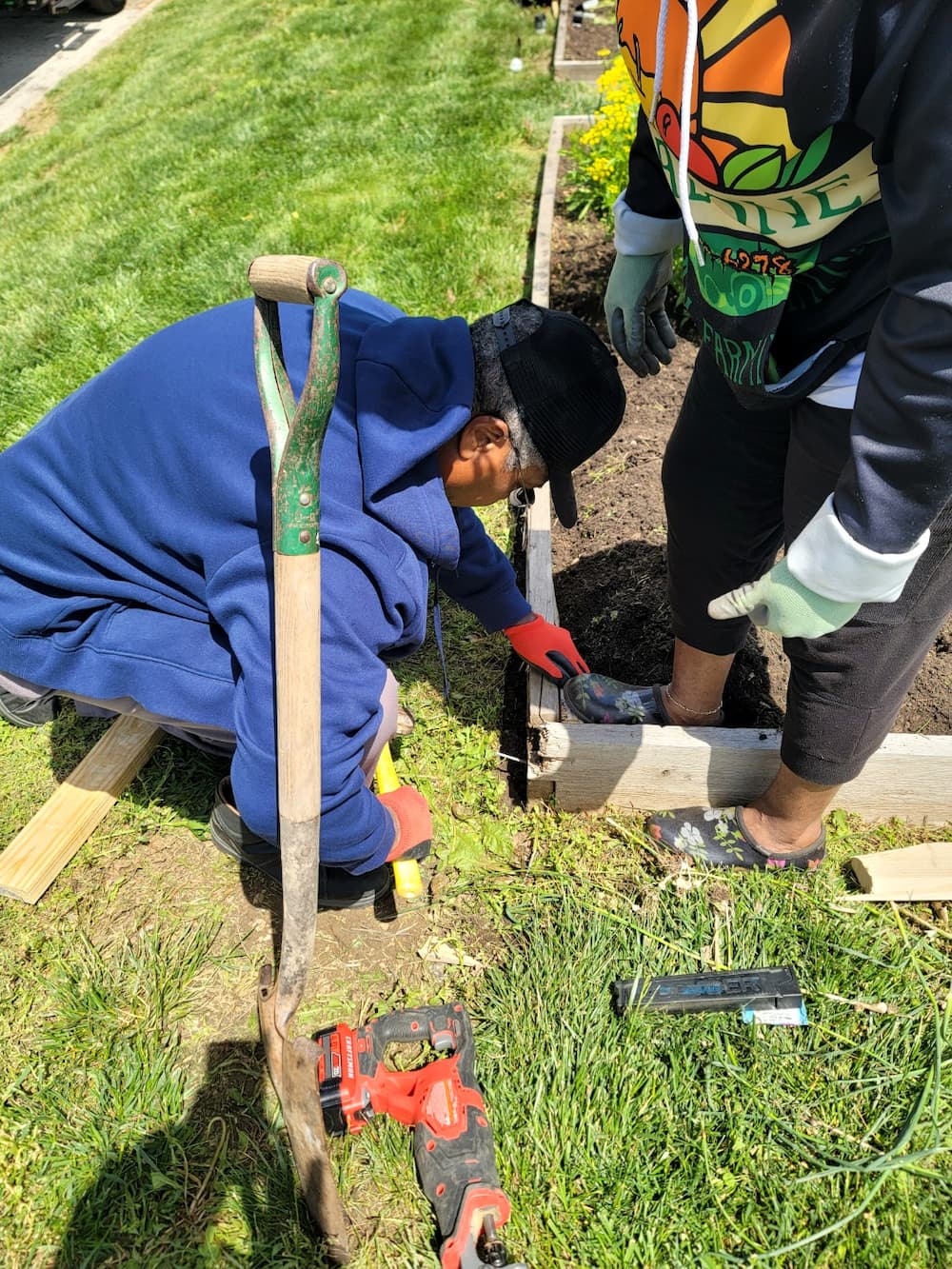 Urban Green Dreams brings people together to prepare a raised garden bed at a site in Kansas City.
Urban Green Dreams brings people together to prepare a raised garden bed at a site in Kansas City.
Through the G.A.R.D.E.N. initiative, LUCE supplies community partners with essential materials — seeds, starter plants, soil, irrigation equipment and tools. In some cases, LUCE also funds local assistance, employing community members to help maintain and manage the gardens throughout the growing season. These combined resources reduce costs for organizers while building local capacity, and they are paired with educational opportunities that extend the garden’s impact beyond harvest.
Through workshops, community events and Train-the-Trainer conferences, the University empowers garden leaders with agricultural education focused on growing practices, nutrition, sustainability and food safety.
“My team, Urban Green Dreams, all show up to the Train-the-Trainer conferences to keep up with what Lincoln has going on — and what Lincoln has to offer,” adds Grimes. “It really brings it full circle.”
These trainings provide guidance and knowledge while also helping participants become local educators — returning to their communities equipped to share what they’ve learned and empower others, expanding the long-term impact of each garden.
“Community outreach is central to our purpose," says Interim Dean of LU’s College of Agriculture, Environmental and Human Sciences and Associate Cooperative Research Director Dr. Tunsisa Hurisso. "By sharing science-backed agricultural knowledge and resources, Lincoln University honors the 1890 land-grant vision and ensures that underserved communities continue to have access to tools for growth and success. Our work in the community gardens reinforces what we teach in the classroom and helps grow future leaders while supporting today’s families and food systems.”
As Lincoln University marks 135 years of land-grant legacy, the statewide community garden network it supports reflects its enduring commitment to education, equity and service. Rooted in the vision of the Second Morrill Act, LUCE’s work continues to bridge gaps in access and cultivate a healthier, more connected future.
Through every seed planted and lesson shared, these gardens continue Lincoln University’s mission to educate, empower and uplift communities across Missouri.
